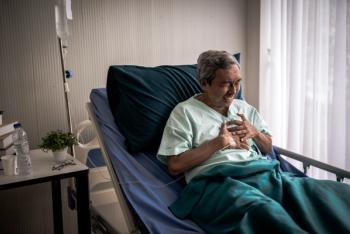
The Future of Survivorship Care: Precision Tools for Women After Breast Cancer
Key Takeaways
- Survivorship care plans often leave patients who finished breast cancer treatment feeling abandoned, highlighting the need for continuous support and monitoring of long-term side effects.
- Exercise and specialized clinics help manage physical and hormonal symptoms, while the Breast Cancer Index tailors endocrine therapy to prevent overtreatment.
The Breast Cancer Index and artificial intelligence–assisted mammograms are tools that can help mitigate symptoms and reassure patient insecurities of women with breast cancer post-treatment.
Survivorship care plans, especially for women diagnosed with
At Memorial Sloan Kettering Cancer Center, Olivo helps women who have survived breast cancer treatments, aiding them in their life post-diagnosis and often through lifelong symptoms as a result of their therapies. The term "survivorship," coined by the National Coalition for Cancer Survivorship, starts from the time of diagnosis and essentially constitutes the remainder of a patient’s life. However, survivorship is more commonly defined as the period succeeding completion of initial treatments, including surgery, radiation therapy, chemotherapy, and immunotherapy.1,2 In Olivo’s experience shepherding women through survivorship, she’s witnessed similar feelings of abandonment and anxiety after intensive treatment ends.
“I think there's a period of vulnerability where they don't have to be seen as frequently, and the appointments get more spaced out, so they feel like they're not being followed as closely,” Olivo said. “That being said, there are long-term side effects that are still present that need to be monitored over time.”
Post-Treatment Symptoms and Avenues of Care
Every type or stage of breast cancer may need different types of treatment, and with that there are several—sometimes temporary—or long-term side effects. The majority of treatments used are often a combination of 1 or 2 of the following: chemotherapy, hormone therapy, targeted therapy, and surgery. As one of the most common treatments, chemotherapy has more well-known side effects based on the type, dosage, and length of treatment. These symptoms often include hair loss, mouth sores, fatigue, loss of appetite, difficulty with memory and concentration, and hormonal side effects (vaginal dryness, hot flashes, potential or premature menopause, and fertility issues), to name a few. The symptoms associated with each treatment are also fairly similar but vary in severity based on the type, dosage, and the person.3
“Exercise is a huge thing that we recommend. It helps with mobility, and it helps with strength training, which can be helpful for bone health, which can be a consequence of some of the medications that we recommend,” Olivo said. “It helps with stress levels. It also helps maintain weight and cardiovascular function, and it also can reduce risk as well.”
In addition to providing recommendations and being active in patients' survivorship care plans, Memorial Sloan Kettering Medical Center in Commack, New York, also has a sexual health clinic, she said. The clinic serves as a guide for women struggling with hormonal symptoms due to treatment and helps them rebuild their libido and develop intimacy, which can sometimes be painful after treatment, Olivo said.
In addition to physical symptoms, Olivo said that women are often fearful or anxious about reoccurrence and not being monitored as closely after their initial treatments. Olivo and her team work to reassure survivors and help them manage their symptoms and feelings.
“At every visit, what we do is always tell them, ‘Listen, we are here for you.’ And I say to all my patients, if at any point, something's just not sitting well with you and you're worried, and it's keeping you up at night, call us and we will talk you through,” Olivo said. “A lot of reassurance, a lot of going over what the symptoms to be aware of [are], and making sure that they are keeping up to date with other doctors and making sure that their general health is preserved as well.”
How Survivorship Care Plans Are Decided
The
While there are more guidelines addressing which therapies are associated with improved outcomes, Olivo and her team use the BCI to help personalize the decisions for patients with hormone-receptor-positive breast cancer. Eligible patients can receive endocrine therapy—a hormone therapy that blocks or suppresses the effects of estrogen and progesterone that can promote the growth of hormone receptor-positive breast cancer.
Hormone therapy also has common side effects that can be mitigated or avoided altogether with the use of the BCI. Some of these symptoms include hot flashes, muscle and joint pain, osteoporosis, headaches, mood swings, and irregular periods.3 Understanding whether the therapy is likely to help reduce the risk of recurrence helps providers and patients evaluate the risks vs benefit of continuing the treatment for longer periods of time.
“What's great about it is I can encourage patients to complete their therapy if they are gaining a big enough benefit, or vice versa,” Olivo said. “I could avoid overtreatment, because if they're really not note likely to receive a benefit from the endocrine therapy, we're able to recommend completion of therapy at the five-year mark and spare some of those side effects from the medications.”
Not only has Olivo said the BCI test has made her job as a provider easier, but it also empowers patients by giving them the opportunity to make an impactful choice in their care. Olivo described the BCI as a tool that patients and doctors can use together to curate a catered survivorship plan that best fits the needs of each individual patient.
AI-Mammograms May Ease Survivorship Care Burdens
Screenings for both breast cancer and other cancers for which patients may have a higher risk of developing due to certain breast cancer treatments are one of the primary points of follow-up in survivorship care. Additional cancers that patients may be susceptible to include salivary gland, uterus, ovary, thyroid, connective tissue and bone, and skin cancers.5
However, Olivo said she’d like to see more non-oncologic specialty providers be active in survivorship care. One of the main tests she says all primary and gynecological physicians should be able to perform is a standard breast exam. At the same time, a
“AI is often used to reprioritize radiologists when there's a low likelihood of malignancy,” study author Sarah Verboom, PhD candidate, said in
“AI systems are getting better every time. I think if we communicate clearly to those women what the performance of AI is and also do their quality control of AI systems,” Verboom said. “I think then women would also be open to just AI reviewing the mammograms if we can guarantee that quality is better than just radiologists in some cases.”
Survivorship in the Era of Precision Medicine
Today, survivorship is about more than monitoring and maintenance—it’s about precision, personalization, and quality of life. Tools like the BCI help tailor long-term treatment decisions, ensuring women aren’t overtreated while protecting those at higher risk of recurrence. Meanwhile, AI-assisted mammography supports ongoing surveillance by catching cancers early, easing radiologist workload, and reducing the anxiety many survivors feel before routine screenings.
Together, these tools reflect a bigger shift in survivorship: moving away from one-size-fits-all care toward plans built around a woman’s biology, risks, and values. At the same time, the promise of precision care raises important questions about equity and access. For advances like AI mammography and genomic testing to have their full impact, they must be available not just in major academic centers but also in community clinics and rural hospitals, where many survivors receive care.
Survivorship isn’t only about extending life after breast cancer. It’s about helping women feel less burdened by their care and more confident about the years ahead.
References
1. Conner K, DePolo J. Breast cancer survivorship. Breastcancer.org August 7, 2025. Accessed September 9, 2025.
2. Staff N, Elleni. Our history. NCCS—National Coalition for Cancer Survivorship. July 21, 2025. Accessed September 9, 2025.
3. Side effects of breast cancer treatment and how to manage them. National Breast Cancer Foundation. April 17, 2025. Accessed September 9, 2025.
4. Raab R, Ismaila N, Andre F, Stearns V, Kalinsky K. Biomarkers for adjuvant endocrine and chemotherapy in early-stage breast cancer: ASCO guideline update Q and A. JCO Oncol Pract. 2022;18(9):646-648. doi:10.1200/OP.22.00230
5. Conner K, DePolo J. Breast cancer survivorship screening and testing. Breastcancer.org. December 2, 2022. Accessed September 9, 2025.
Newsletter
Stay ahead of policy, cost, and value—subscribe to AJMC for expert insights at the intersection of clinical care and health economics.







































